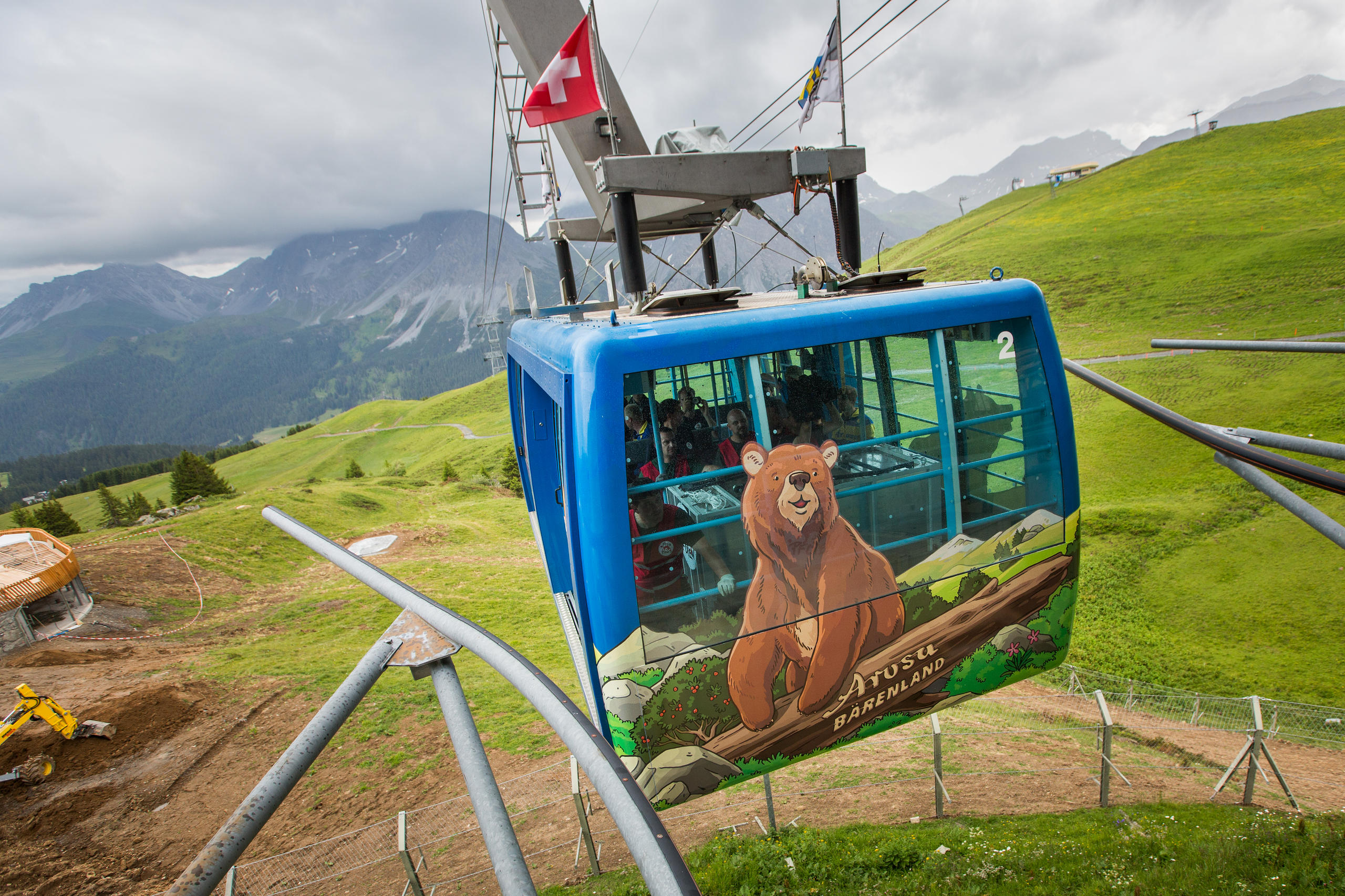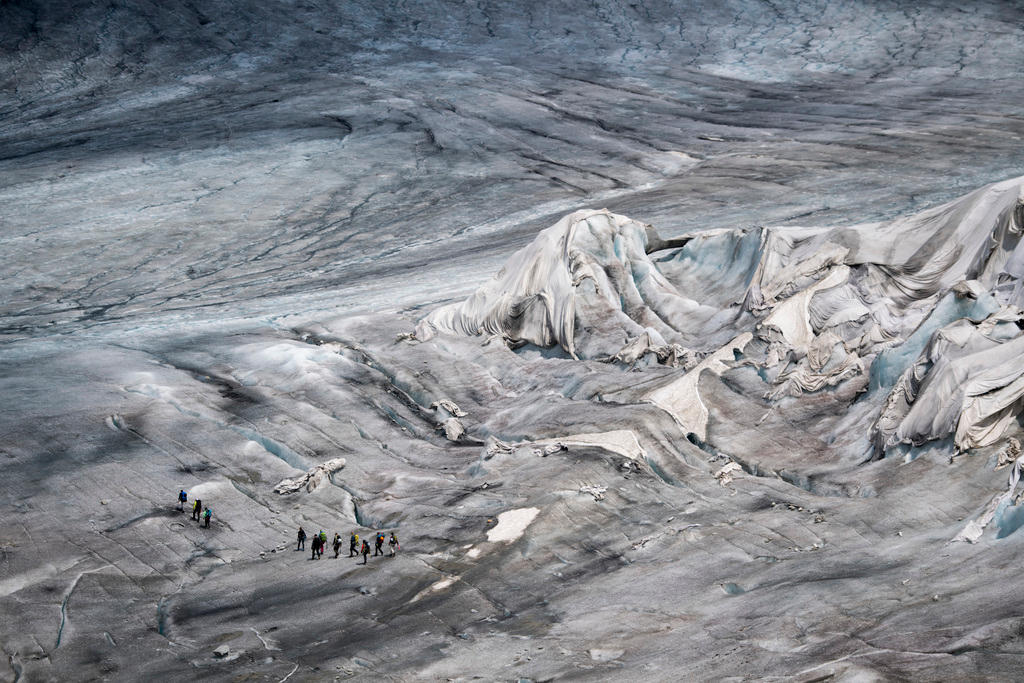This profession calls for you to put your life at risk
The judgement of the mountain guide can be called into question when a fatal accident happens in the Alps, like the one this summer when seven climbers lost their lives.
But if there is anyone who risks his life for the safety of climbers it is the one who leads them, says Pierre Mathey, who has been an Alpine guide for more than 25 years.
With dozens of peaks over 4,000 metres, Switzerland is an inevitable destination for those who seek high-altitude adventure. Every year thousands of people try their hand at climbing the Matterhorn or the Jungfrau, driven by the desire to conquer a peak. “Someone who doesn’t manage to reach the summit talks in terms of failing. In my view, the only failure is if they don’t make it back home”, says Mathey (52), who has been a guide for over 25 years and is general secretary of the Swiss Mountain Guide AssociationExternal link (ASGM).External link
swissinfo.ch: From the stories appearing in the media, one might think that accidents in the mountains are on the increase. Is that the case?
Pierre Mathey: No. Fortunately, it’s the very opposite. In proportion to the number of people climbing in Switzerland, the number of accidents is going down, both summer and winter. You can see this trend in just about all the Alpine countries.
swissinfo.ch: Why are there fewer fatalities, then?
P. M.: Today we have better equipment, for example more sophisticated tools for finding people in avalanches. But it’s not just that. Information and prevention have got better too. I am thinking of the avalanche bulletin. Switzerland is the only country in the world that puts out two bulletins a day, one in the morning and one in the late afternoon.
Another important aspect here is the training mountain guides have, and the degree of preparedness of amateur climbers and hikers, who can take refresher courses through their Alpine clubs.
swissinfo.ch: Are accidents always due to human error?
P. M.: There is always a human factor involved, but it’s not always right to call it an “error”. When you go up into the the mountains, you have to be prepared to accept the element of the unexpected. The mountains are not regulated, and it’s not a place that is checked for safety every so often, as a highway would be, say.
You often read that “the mountain has claimed someone’s life”. That’s not really true: the mountain doesn’t kill anybody. For sure, it has objective risks associated with it, like a crevasse, a rock fall or an avalanche. And yet, we climbers are the ones who put ourselves at risk whenever we decide to go up the the mountains. The job of professional guides is to manage that risk and keep it to a minimum – both for the customer and for ourselves.
swissinfo.ch: Most accidents are said to happen during the descent afterwards. Why is that?
P. M.: There are two reasons. The first is a matter of simple physics: when you’re climbing, you’re going against earth’s gravity, and that requires a physical effort that protects you from falls. When you’re going down again, apart from gravity drawing you downwards, there is the whole dynamic of the descent, which leads to falls. Beyond that, there is a simple human explanation: you may be tired and inattentive after putting out such an effort to reach the top.
swissinfo.ch: The Matterhorn has claimed more victims than any mountain in the world. Since the first time it was climbed in 1865 over 500 people have died there. Is it a particularly dangerous place, or are there just a lot of people climbing it?
P. M.: It’s both, really. Every year 3,000 people climb the Matterhorn. But just to give a comparison, on Mont Blanc, it’s 20,000. There, there are many accidents, not always fatal ones. Climbing the Matterhorn is especially difficult, though. You cross quite a few ridges, and one false step almost always means you fall to your death.
swissinfo.ch: The accident at the end of April in the Valais, when seven people died – six Italians and one Bulgarian – was one of the worst in recent years. What can be learned from a tragedy like that?
P. M.: For three years now we have been stepping up the exchange of information to know about errors and accidents. As regards what happened on the Pigne d’Arolla, it’s really too early to draw any conclusions. But when something like that happens, you can tell there were a whole lot of things that didn’t work. There was a chain of chance negative events. It was a terrible tragedy, the kind that thankfully happens no more than once in 50 years.
swissinfo.ch: Some commentators blamed the guide who was accompanying the group.
P. M.: I do not think there was any justification for calling it human error. The guide had a large group there, but they were pretty experienced climbers. It’s hard to say what actually happened. Perhaps, at some point, nature just got too strong for the guide.
swissinfo.ch: How do you stay safe in the the mountains?
P. M.: It’s a number of things: technical training, experience, and above all, mental flexibility. Dealing with nature, we have to stay humble, because it is always going to be stronger than we are. I don’t like to hear people saying things like ’we conquered the peak’. Nature can’t be conquered. You don’t go up the the mountains to conquer anything, but to have an unforgettable experience, to feel emotions. It’s not without reason when people say that Alpine guides are ‘makers of memories’.
swissinfo.ch: Is it a requirement to have a guide?
P. M.: No. The Alps are an exception in the whole world: access is free. There are no tolls and no rules.
swissinfo.ch: How much does a guide make in Switzerland?
P. M.: The average is CHF650 ($653) per day. But note that a working day may last 10 to 12 hours, so the hourly wage turns out to be quite low. To climb the Matterhorn, say, you would need two days, and the standard fee is CHF1300. The guide is always exposed to economic uncertainty, by the way: if there is a cancellation he ends up making no money.
swissinfo.ch: A colleague of yours has said “the job of the the Alpine guide is the only one where you make a living trying not to lose your own life”. What do you think?
M. P.: To tell you the truth… that’s a horrible way of putting it (laughs). It is a risky business, for sure, but it’s a calculated, controlled risk. Yet you can’t deny it: ours is one of the few jobs where you put your life at risk. Just to come back to the accident on the Pigne d’Arolla: even if the Italian guide made a mistake – the courts will have to decide that – he gave his life trying to save his customers. What more can you ask?
swissinfo.ch: What changes have you seen in the job in your 25 years of work?
P. M.: Today the clientele is more varied, more international. It changes every day or two. At one time you always saw the same groups of customers. People came back to you, or they stayed with the same guide for several weeks. The relationship with the customer has changed too. In the past, the guide led the way and the customer followed. Today interaction is a lot more intense. The customer has more information at his disposal and wants to share and discuss, not just about the the mountains, but things in general.
swissinfo.ch: Have you found yourself in critical situations?
P. M.: Yes, several times. I have had to spend nights in the open. Fortunately I have never had a serious accident.
swissinfo.ch: What is the most important advice you can give to Alpine enthusiasts?
P. M.: Be well informed about weather conditions and the terrain, have the right equipment, and bring extra supplies. Don’t forget that tiredness and cold can be a real hazard to life and limb. Information and prevention are essential. Remember to tell people where you’re going, and if you find yourself in difficulty or danger, don’t hesitate to call in help.
How to recognise an experienced guide?
The Swiss Mountain Guide Association (ASGMExternal link) has reported an increase in the number of guides who work illegally or without proper authorisation. In addition to representing unfair competition, these people, often foreigners rather than locals familiar with the area, can put their customers’ lives at risk.
Pierre Mathey, secretary of the ASGM, therefore recommends that you contact the offices of mountain guides or mountaineering schools, which exist in every region of Switzerland. He also recommends consulting the database of the association: if the name of your guide is on this list, then it means that he is qualified and authorised to accompany you to the mountains.
Translated from Italian by Terrence MacNamee

In compliance with the JTI standards
More: SWI swissinfo.ch certified by the Journalism Trust Initiative














You can find an overview of ongoing debates with our journalists here . Please join us!
If you want to start a conversation about a topic raised in this article or want to report factual errors, email us at english@swissinfo.ch.